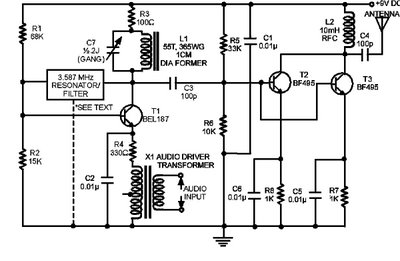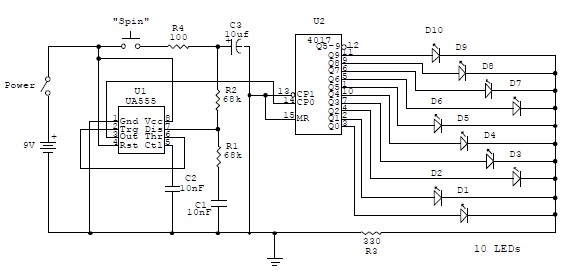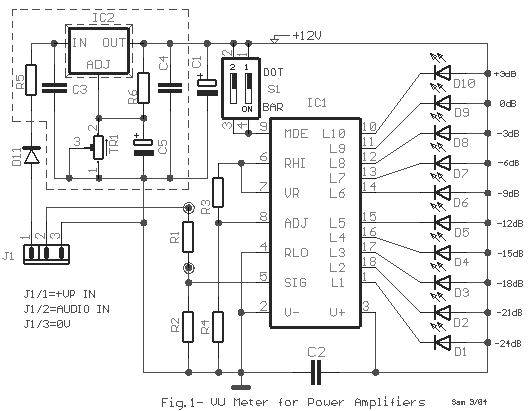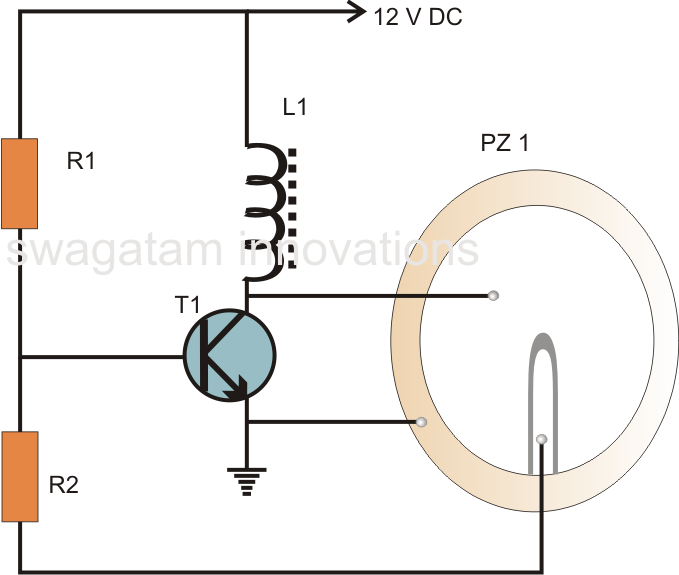
home telephone fm transmitter circuit
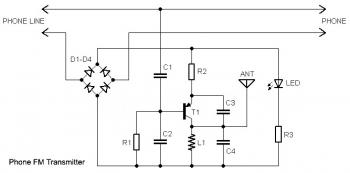
This circuit connects in series with a home phone line and transmits phone conversations through the FM band whenever the telephone handset is picked up. The transmitted signal can be tuned by any FM receiver. The circuit includes an "On Air" LED indicator and features a switch that can be used to turn off the transmitter. A notable characteristic of the circuit is that it does not require a battery for operation, as it draws electrical power from the phone line. The transmitter circuit utilizes a short wire aerial, approximately 4 inches (10 cm) long, to transmit the signal, and a portion of the RF signal can also be radiated through the phone line itself. The circuit may be used to share or record conversations but is not intended for illegal use.
This circuit operates by integrating with the existing telephone line infrastructure, allowing for real-time audio transmission over the FM band. The series connection ensures that the circuit does not interfere with the normal operation of the phone line. When the handset is lifted, the circuit activates, and the audio signal is modulated onto an FM carrier wave. The tuning capability of any standard FM receiver allows users to select the appropriate frequency to listen to the transmitted conversation.
The "On Air" LED indicator serves as a visual cue, informing the user when the transmitter is active. This feature is particularly important for ensuring that conversations are not inadvertently broadcasted to unintended receivers. The inclusion of a switch to deactivate the transmitter allows for user control, enhancing privacy and preventing unauthorized transmission.
Powering the circuit directly from the phone line eliminates the need for an external power source, making the design more convenient and compact. The short wire aerial is designed to be efficient in transmitting the modulated signal over a limited range, suitable for local reception. Additionally, the ability of the phone line to radiate a portion of the RF signal expands the effective transmission range without compromising the integrity of the phone line itself.
While this circuit can facilitate the sharing or recording of conversations, it is imperative to note that it must be used in compliance with legal regulations governing privacy and telecommunications. The design emphasizes ethical use, ensuring that users are aware of the implications of broadcasting private conversations.This circuit connects in series with your home phone line and delivers the phone conversation through the FM band any time you pick up the telephone handset. Transmitted signal could be tuned by any FM receiver. The circuit features an "On Air" LED indicator and also gives you a switch t hat can be utilized to turn off the transmitter. A special characteristic of the circuit is the fact that no battery is required to operate the circuit because electrical power is taken from your phone line. The transmitter circuit works by using only a short piece of wire aerial about 4" / 10 cm long to transmit the signal and a portion of the RF signal can also be radiated via the phone line itself.
The circuit may possibly be implemented to share or record conversations, but will not be meant for illegal use. 🔗 External reference
This circuit operates by integrating with the existing telephone line infrastructure, allowing for real-time audio transmission over the FM band. The series connection ensures that the circuit does not interfere with the normal operation of the phone line. When the handset is lifted, the circuit activates, and the audio signal is modulated onto an FM carrier wave. The tuning capability of any standard FM receiver allows users to select the appropriate frequency to listen to the transmitted conversation.
The "On Air" LED indicator serves as a visual cue, informing the user when the transmitter is active. This feature is particularly important for ensuring that conversations are not inadvertently broadcasted to unintended receivers. The inclusion of a switch to deactivate the transmitter allows for user control, enhancing privacy and preventing unauthorized transmission.
Powering the circuit directly from the phone line eliminates the need for an external power source, making the design more convenient and compact. The short wire aerial is designed to be efficient in transmitting the modulated signal over a limited range, suitable for local reception. Additionally, the ability of the phone line to radiate a portion of the RF signal expands the effective transmission range without compromising the integrity of the phone line itself.
While this circuit can facilitate the sharing or recording of conversations, it is imperative to note that it must be used in compliance with legal regulations governing privacy and telecommunications. The design emphasizes ethical use, ensuring that users are aware of the implications of broadcasting private conversations.This circuit connects in series with your home phone line and delivers the phone conversation through the FM band any time you pick up the telephone handset. Transmitted signal could be tuned by any FM receiver. The circuit features an "On Air" LED indicator and also gives you a switch t hat can be utilized to turn off the transmitter. A special characteristic of the circuit is the fact that no battery is required to operate the circuit because electrical power is taken from your phone line. The transmitter circuit works by using only a short piece of wire aerial about 4" / 10 cm long to transmit the signal and a portion of the RF signal can also be radiated via the phone line itself.
The circuit may possibly be implemented to share or record conversations, but will not be meant for illegal use. 🔗 External reference
Warning: include(partials/cookie-banner.php): Failed to open stream: Permission denied in /var/www/html/nextgr/view-circuit.php on line 713
Warning: include(): Failed opening 'partials/cookie-banner.php' for inclusion (include_path='.:/usr/share/php') in /var/www/html/nextgr/view-circuit.php on line 713

